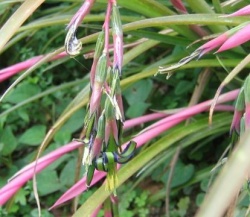





Botanical Name: Billbergia nutans
This member of the Bromeliaceae family is one of the easiest to grow indoors...and one of the most striking.
Its thick, strap-like leaves grow into an upright rosette, creating an urn that must be filled with water at all times. As the plant matures, the leaves arch outward, lending a graceful appearance. The foliage can reach up to 15 inches (37.5 cm) tall and about twice as wide, so give this bromeliad plant some room to spread out.
You can expect flowers in spring when the plant reaches maturity, usually in 2-3 years.
The flowers are pink, purple, yellow or green and are surrounded by red or pink bracts. Billbergia nutans gets one of its common names, Queen's Tears, from the drops of nectar that "weep" from the flowers when the plant is moved or touched.
Because Billbergia nutans readily produces offsets that can be shared with friends, it is also commonly known as Friendship Plant.
Most bromeliads are epiphytes in their native rainforest habitat. They have small roots, mainly used for anchoring themselves on trees, so these tree-dwelling plants gather moisture and nutrients through their leaves.
Repot in spring. Young plants should be repotted every year. Use a loose, fir bark mix, such as an orchid mix or one specially labeled for bromeliads. Never repot a plant while it is flowering. Wait till after flowering to repot the offsets.
Got a late bloomer? Bromes that don't produce blooms aren't getting enough light. Move your plant to a brighter location. Moving it outdoors for the summer to a partially shaded spot may be just what it needs.
You can encourage bromeliads to flower by adding a pinch of Epsom salts (magnesium sulfate) to the water or fertilizer.
Still won't bloom? Give it a nudge with this easy trick: Place a ripe apple or a few apple cores around the plant and enclose the whole thing in a clear plastic bag for a week or two. Ripening apples produce ethylene gas that encourages flower buds to form. Keep your plant out of direct sun while it's covered with plastic to prevent it from getting too hot.

Origin: Argentina, Brazil and Uruguay
Height: 15 in (37.5 cm) tall
Light: Bright, indirect light. If you move your billbergia outdoors for the summer, keep it in partial shade. Keep an eye on it so the leaves don't turn red or get scorched from too much sun.
Water: Water the center of the rosette and keep room-temperature rainwater or distilled water in its urn (center of the rosette) at all times. Water soil just enough to keep the roots barely moist. Empty old water from the urn once a month and promptly replace it with fresh water. Do not soak base of plant, which can lead to root rot. In fall and winter, keep the soil slightly drier.
Humidity: Moderate humidity. Brown tips on leaves are caused by dry air. Although billbergias are more tolerant of dry air than other bromeliads, they benefit from frequent misting with water to increase the humidity.
Temperature: In spring and summer, warm temperatures (65-80°F/18-27°C). In fall and winter, average room temperatures (60-75°F/16-24°C).
Soil: Bromeliad or orchid mix
Fertilizer: Feed every 2 weeks in spring and summer with a balanced liquid fertilizer diluted to half strength. In fall and winter, feed once a month. Use a foliar fertilizer, if you want. Bromeliads take in moisture and nutrients through their leaves so you can add fertilizer to water and spray it on the leaves.
Propagation: Remove offsets -- called pups -- that grow at the base of the plant when they are at least 6 in (15 cm) tall with a sharp knife and pot separately in fresh potting mix. Wait till after flowering to pot up offsets.
Copyright © www.100flowers.win Botanic Garden All Rights Reserved